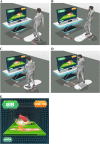Effects of interactive video-game-based exercise on balance in older adults with mild-to-moderate Parkinson's disease
- PMID: 32660512
- PMCID: PMC7359629
- DOI: 10.1186/s12984-020-00725-y
Effects of interactive video-game-based exercise on balance in older adults with mild-to-moderate Parkinson's disease
Abstract
Background: This study aimed to evaluate the effectiveness of a customized interactive video game-based (IVGB) training on balance in older adults with mild-to-moderate Parkinson's disease (PD).
Methods: In this 12-week crossover trial, PD patients ≥65 years of age were randomly divided into Group A (a 6-week intervention phase followed by a 6-week control phase) and Group B (a 6-week control phase followed by a 6-week intervention phase). Participants received IVGB exercise training during the intervention phase and no exercise during the control phase. Functional outcomes were measured using behavioral evaluation scales and questionnaires at baseline, week 6 and week 12.
Results: Twenty-four PD patients were included in this study, and were evenly divided into two groups. After Bonferroni adjustment, the changes in Modified Falls Efficacy Scale (MFES) and two subscales of Multi-Directional Reach Test were significantly different between two groups in the first 6-week period. In addition, the changes in Berg Balance Scale, MFES, and two subscales of Maximum Step Length were significantly different between two groups in the second 6-week period. Compared to controls, 6-week IVGB exercise intervention significantly improved different but overlapping functional outcomes in two groups of PD patients.
Conclusions: The customized IVGB exercise training improves balance, postural stability and confidence in preventing falls in older adults with mild-to-moderate PD. However, this IVGB exercise doesn't have a significant impact on quality of life.
Trial registration: ClinicalTrials.gov. NCT03689764 . Registered 27 September 2018, retrospectively registered.
Keywords: Balance; Crossover trial; Interactive video game-based exercise; Parkinson’s disease.
Conflict of interest statement
The authors declare no conflict of interests.
Figures




References
-
- de Lau LM, Breteler MM. Epidemiology of Parkinson's disease. Lancet Neurol. 2006;5(6):525–535. - PubMed
-
- Dibble LE, Addison O, Papa E. The effects of exercise on balance in persons with Parkinson's disease: a systematic review across the disability spectrum. J Neurol Phys Ther. 2009;33(1):14–26. - PubMed
-
- Johansson C, et al. Balance and mobility in patients with newly diagnosed Parkinson’s disease. Disabil Rehabil. 2020;42(6):770–8. 10.1080/09638288.2018.1509240. - PubMed
-
- Crizzle AM, Newhouse IJ. Is physical exercise beneficial for persons with Parkinson's disease? Clin J Sport Med. 2006;16(5):422–425. - PubMed
-
- Rantakokko M, et al. Life-space mobility in Parkinson's disease: associations with motor and non-motor symptoms. J Gerontol A Biol Sci Med Sci. 2019;74(4):507–512. - PubMed
Publication types
MeSH terms
Associated data
LinkOut - more resources
Full Text Sources
Medical

